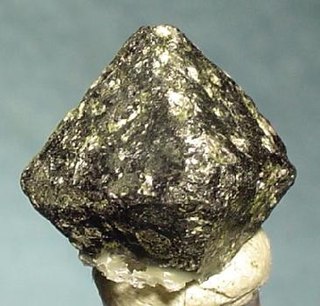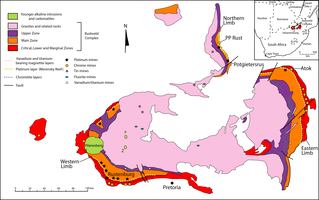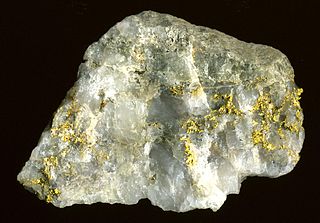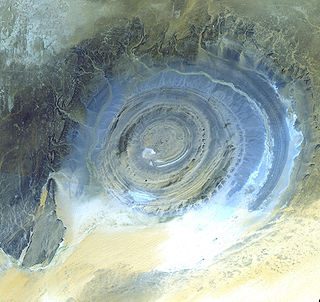Related Research Articles

Ore is natural rock or sediment that contains one or more valuable minerals concentrated above background levels, typically containing metals, that can be mined, treated and sold at a profit. The grade of ore refers to the concentration of the desired material it contains. The value of the metals or minerals a rock contains must be weighed against the cost of extraction to determine whether it is of sufficiently high grade to be worth mining, and is therefore considered an ore. A complex ore is one containing more than one valuable mineral.

Underground hard-rock mining refers to various underground mining techniques used to excavate "hard" minerals, usually those containing metals, such as ore containing gold, silver, iron, copper, zinc, nickel, tin, and lead. It also involves the same techniques used to excavate ores of gems, such as diamonds and rubies. Soft-rock mining refers to the excavation of softer minerals, such as salt, coal, and oil sands.

Volcanism, vulcanism or volcanicity is the phenomenon of eruption of molten rock (magma) onto the surface of the Earth or a solid-surface planet or moon, where lava, pyroclastics, and volcanic gases erupt through a break in the surface called a vent. It includes all phenomena resulting from and causing magma within the crust or mantle of the body, to rise through the crust and form volcanic rocks on the surface. Magmas that reach the surface and solidify form extrusive landforms.

Open-pit mining, also known as open-cast or open-cut mining and in larger contexts mega-mining, is a surface mining technique of extracting rock or minerals from the earth from an open-air pit, sometimes known as a borrow.

The Witwatersrand is a 56-kilometre-long (35 mi), north-facing scarp in South Africa. It consists of a hard, erosion-resistant quartzite metamorphic rock, over which several north-flowing rivers form waterfalls, which account for the name Witwatersrand, meaning "white water ridge" in Afrikaans. This east-west-running scarp can be traced with only one short gap, from Bedfordview in the east, through Johannesburg and Roodepoort, to Krugersdorp in the west.
The platinum-group metals are six noble, precious metallic elements clustered together in the periodic table. These elements are all transition metals in the d-block.

Chromite is a crystalline mineral composed primarily of iron(II) oxide and chromium(III) oxide compounds. It can be represented by the chemical formula of FeCr2O4. It is an oxide mineral belonging to the spinel group. The element magnesium can substitute for iron in variable amounts as it forms a solid solution with magnesiochromite (MgCr2O4). A substitution of the element aluminium can also occur, leading to hercynite (FeAl2O4). Chromite today is mined particularly to make stainless steel through the production of ferrochrome (FeCr), which is an iron-chromium alloy.

The Bushveld Igneous Complex (BIC) is the largest layered igneous intrusion within the Earth's crust. It has been tilted and eroded forming the outcrops around what appears to be the edge of a great geological basin: the Transvaal Basin. It is approximately 2 billion years old and is divided into four different limbs: the northern, southern, eastern, and western limbs. The Bushveld Complex comprises the Rustenburg Layered suite, the Lebowa Granites and the Rooiberg Felsics, that are overlain by the Karoo sediments. The site was first publicised around 1897 by Gustaaf Molengraaff who found the native South African tribes residing in and around the area.

The Great Dyke is a linear geological feature that trends nearly north-south through the centre of Zimbabwe passing just to the west of the capital, Harare. It consists of a band of short, narrow ridges and hills spanning for approximately 550 kilometres (340 mi). The hills become taller as the range goes north, and reach up to 460 metres (1,510 ft) above the Mvurwi Range. The range is host to vast ore deposits, including gold, silver, chromium, platinum, nickel and asbestos.

Various theories of ore genesis explain how the various types of mineral deposits form within Earth's crust. Ore-genesis theories vary depending on the mineral or commodity examined.

A layered intrusion is a large sill-like body of igneous rock which exhibits vertical layering or differences in composition and texture. These intrusions can be many kilometres in area covering from around 100 km2 (39 sq mi) to over 50,000 km2 (19,000 sq mi) and several hundred metres to over one kilometre (3,300 ft) in thickness. While most layered intrusions are Archean to Proterozoic in age, they may be any age such as the Cenozoic Skaergaard intrusion of east Greenland or the Rum layered intrusion in Scotland. Although most are ultramafic to mafic in composition, the Ilimaussaq intrusive complex of Greenland is an alkalic intrusion.

Cumulate rocks are igneous rocks formed by the accumulation of crystals from a magma either by settling or floating. Cumulate rocks are named according to their texture; cumulate texture is diagnostic of the conditions of formation of this group of igneous rocks. Cumulates can be deposited on top of other older cumulates of different composition and colour, typically giving the cumulate rock a layered or banded appearance.

A dome is a feature in structural geology consisting of symmetrical anticlines that intersect each other at their respective apices. Intact, domes are distinct, rounded, spherical-to-ellipsoidal-shaped protrusions on the Earth's surface. However, a transect parallel to Earth's surface of a dome features concentric rings of strata. Consequently, if the top of a dome has been eroded flat, the resulting structure in plan view appears as a bullseye, with the youngest rock layers at the outside, and each ring growing progressively older moving inwards. These strata would have been horizontal at the time of deposition, then later deformed by the uplift associated with dome formation.

Pseudotachylyte is an extremely fine-grained to glassy, dark, cohesive rock occurring as veins that form through frictional melting and subsequent quenching during earthquakes, large-scale landslides, and impacts events. Chemical composition of pseudotachylyte generally reflects the local bulk chemistry, though may skew to slightly more mafic compositions due to the preferential incorporation of hydrous and ferro-magnesian minerals into the melt phase.

Hans Merensky was a South African geologist, prospector, scientist, conservationist and philanthropist. He discovered the rich deposit of alluvial diamonds at Alexander Bay in Namaqualand, vast platinum and chrome reefs at Lydenburg, Rustenburg and Potgietersrus, which led to some of the largest platinum mines in the world, phosphates and copper at Phalaborwa in the Transvaal lowveld, gold in the Free State and the world's biggest chrome deposit at Jagdlust near Pietersburg.

The Merensky Reef is a layer of igneous rock in the Bushveld Igneous Complex (BIC) in the North West, Limpopo, Gauteng and Mpumalanga provinces of South Africa which together with an underlying layer, the Upper Group 2 Reef (UG2), contains most of the world's known reserves of platinum group metals (PGMs) or platinum group elements (PGEs)—platinum, palladium, rhodium, ruthenium, iridium and osmium. The Reef is 46 cm thick and bounded by thin chromite seams or stringers. The composition consists predominantly of cumulate rocks, including leuconorite, anorthosite, chromitite, and melanorite.
Mars may contain ores that would be very useful to potential colonists. The abundance of volcanic features together with widespread cratering are strong evidence for a variety of ores. While nothing may be found on Mars that would justify the high cost of transport to Earth, the more ores that future colonists can obtain from Mars, the easier it would be to build colonies there.

The Marula Mine is a platinum mine located in the Limpopo province of South Africa. It is in the eastern limb of the Bushveld Igneous Complex, approximately 35km north-west of Burgersfort. The operation comprises two decline shaft systems which are used to access the UG2 reef.
Northam Holdings is an independent integrated PGM producer listed on the JSE. The primary operations are centered on their three wholly owned mines, Zondereinde, Booysendal and Eland, and the additional metallurgical operations at Zondereinde including a smelter and base metals removal plant. Northam’s three main products mined are platinum, palladium and rhodium and are consumed by industries such as the motor manufacturing, jewellery and other industrial sectors.
Kajora Area is one of the 14 operational areas of Eastern Coalfields Limited located in Durgapur subdivision of Paschim Bardhaman district in the state of West Bengal, India.
References
- ↑ Kamo, S.L; Reimold, W.U; Krogh, T.E; Colliston, W.P (1996), "A 2.023 Ga age for the Vredefort impact event and a first report of shock metamorphosed zircons in pseudotachylitic breccias and Granophyre", Earth and Planetary Science Letters, 144 (3–4): 369, doi:10.1016/S0012-821X(96)00180-X
- ↑ The morphology of potholes in the UG2 chromitite layer and Merensky Reef (pothole reef facies) at Union Section, Rustenberg Platinum Mines - K. G. Lomberg, M. A. Patterson, J. E. Venter, and E. S. Martin
- Predictability of Pothole Characteristics and their Spatial Distribution at Rustenburg Platinum Mine - Chitiyo, Schweitzer, de Waal, Lambert and Ogilvie (Journal of the Southern African Institute of Mining and Metallurgy - December 2008)